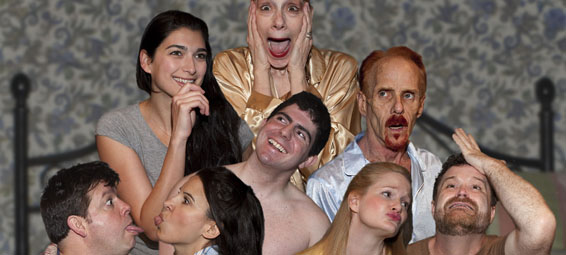When I first walked into Gabriel Acavedo Velarde’s exhibition at the Modern Art Museum Fort Worth, I was almost immediately confronted by a guard who wanted to announce his skepticism. “There y’are” he said “this is a work of art.” His guidance, dripping with sarcasm, continued to describe what was in front of us – a pile of gray gravel covered with a bright orange tarp with ten small speakers poking through. Every now and then the speakers emitted a crackling sound. “Every six seconds as far’s I can tell” the guard said.
The guard, whose demeanor was almost as obnoxious as his art criticism, proceeded to show me the next gallery. It was filled with another tarp held aloft by a series of pulleys that reach out from the gallery and arch across the ceiling like a cat’s cradle network of geometrical vectors that end with ropes that are tethered to the wall. The tarp had garbage strewn across it – a cereal box, paper plates, plastic take out containers and a few pieces of crumpled paper – all of which the guard noted were intentional as he pointed mockingly to the wall text. The pulleys were interactive and viewers are invited to pull them to watch the bright orange tarp bob up and down, throwing the trash to and fro. A bunch of “cheap thrills” he said as he pulled on one of them.
This encounter became more poignant than it might have initially seemed when I entered the third and final gallery of Acavedo Velarde’s installation. It contained a large, two-roomed tent made out of the same orange tarp material used in the other rooms. Inside the tent are two videos, The first is a quasi-documentary investigation of musical tastes in Lima, Peru where Acavedo Velarde grew up. The video consists mostly of interviews with random people on the street about their musical tastes. At first, most interviewed demonstrated their openness by saying that they like a little of everything. But when pressed by the artist’s questions they revealed that taste is often driven by complex issues connected to class.

In Acavedo Velarde’s interviews respondents talk about musical styles like chicha, cumbia, salsa, electronica and rock. Between the artist’s voiceover and the talking heads we come to understand that chicha is favored by poor immigrants to Lima from the Andes that arrived in the 1970’s and 80’s. It is described as hard, rough and chaotic. Like an ethnographer, Acavedo Velarde finds that many say that they don’t like music that doesn’t make sense and that in this evaluation of something aesthetic some are also describing the cultural quality of a class that is lower than theirs.
Electronica for instance, is described as having better style and is related to northern America and Europe and as a result a “higher economy.” “Techno is for rich people” one person says. Acavedo Velarde’s second video, on a monitor that one has to sit on the ground on some packing blankets to watch, implicates himself and his own cultural context into this debate about taste and its relationship to both aesthetics and politics. He begins the video by describing the fact that he used to hate pop music when he lived in Peru but at the age of 23 he left the country and while living as an expatriate has come to like pop music. He thought that perhaps his parents, both leftists, might have affected his aversion to pop music because it was too connected to capitalist forces. But he comes to find that this was not the case.
As Andrea Karnes, the curator of the exhibition notes in the accompanying brochure, Acavedo Velarde’s work relates to what the French curator Nicolas Bourriaud dubbed Relational Aesthetics. This term was meant to refer to an artist’s work that explicitly implicates and engages the social practice of a work of art and the content to which it refers. In this sense this exhibition combines a number of complex interwoven questions related to both taste and class. It also frames my encounter with the guard as part of the artwork, as the strategies of the artist have erased the traditional boundaries between artist, artwork and viewer. The artwork frames the gallery space as the set for a performance – in this case one that opens more questions that it answers. To my mind this is a good thing and one that raises the possibility for both social and aesthetic change. To this end the museum becomes a generative space and not a reliquary for the preservation of past or even recent histories. For taking the risk of using artwork as an unsettling device, both the artist and curator should be commended.
(Photo: Runway Blanket, 2010)





